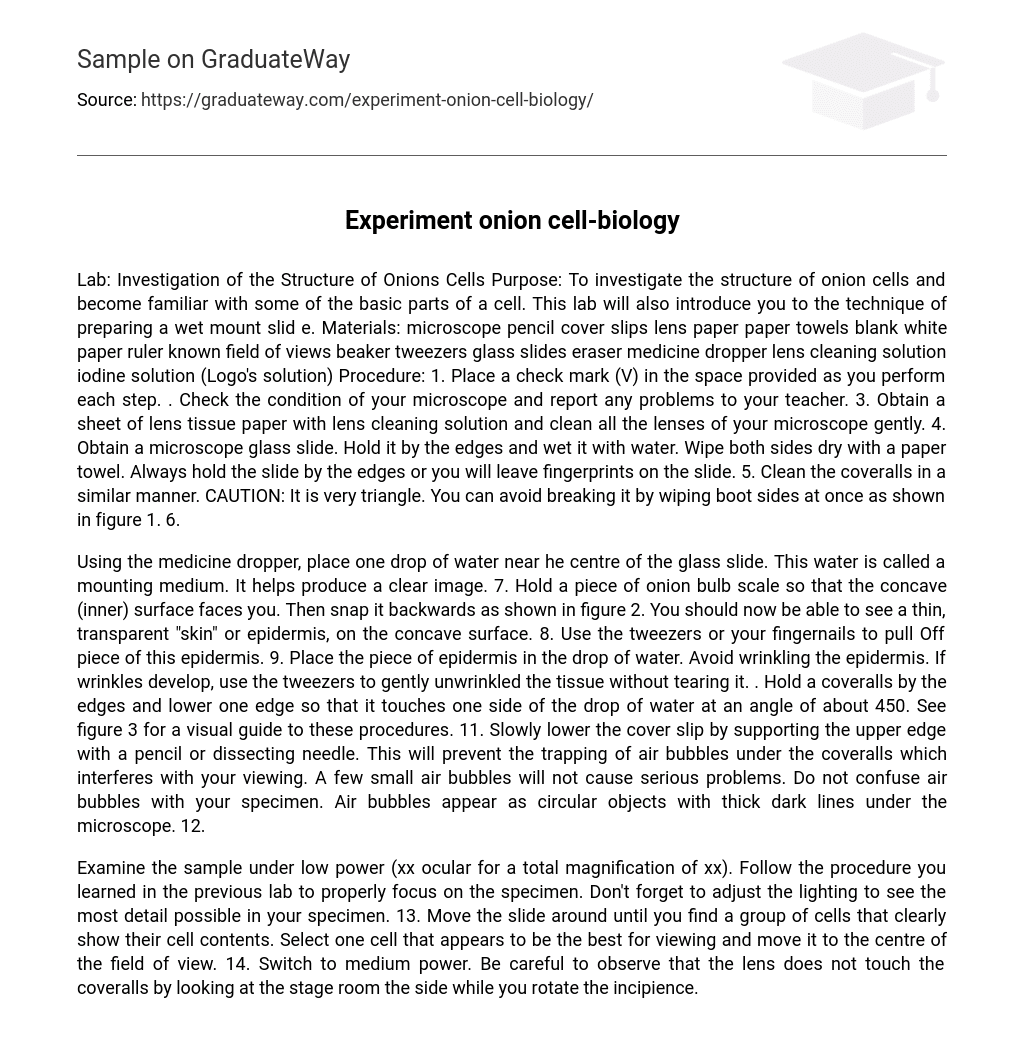Lab: Investigation of the Structure of Onion Cells
Purpose: To investigate the structure of onion cells and become familiar with some of the basic parts of a cell. This lab will also introduce you to the technique of preparing a wet mount slide.
Materials: microscope, pencil, cover slips, lens paper, paper towels, blank white paper, ruler, known field of views, beaker, tweezers, glass slides, eraser, medicine dropper, lens cleaning solution, iodine solution (Logo’s solution)
Procedure:
1. Place a check mark (V) in the space provided as you perform each step.
2. Check the condition of your microscope and report any problems to your teacher.
3. Obtain a sheet of lens tissue paper with lens cleaning solution and clean all the lenses of your microscope gently.
4. Obtain a microscope glass slide. Hold it by the edges and wet it with water. Wipe both sides dry with a paper towel. Always hold the slide by the edges or you will leave fingerprints on the slide.
5. Clean the coveralls in a similar manner. CAUTION: It is very triangle. You can avoid breaking it by wiping both sides at once as shown in figure 1.
Using a medicine dropper, place a drop of water in the center of the glass slide. This water, known as a mounting medium, aids in producing a clear image. Now, hold an onion bulb scale so that the inner surface faces you and snap it backward to reveal a thin, transparent skin called epidermis. Using tweezers or fingernails, remove a piece of this epidermis and place it in the water drop. Be careful not to wrinkle the tissue, but if wrinkles develop, gently use tweezers to smooth them out. Take a cover slip and angle one edge so that it touches one side of the drop of water at approximately 45 degrees. Refer to figure 3 for visual guidance during these steps. Carefully lower the cover slip by supporting the upper edge with a pencil or dissecting needle to avoid trapping air bubbles. Note that a few small air bubbles won’t cause significant issues, but don’t mistake them for your specimen. Under the microscope, air bubbles will appear as circular objects with thick dark lines.
Under low power (using xx ocular for a total magnification of xx), analyze the provided sample. Utilize the previously learned procedure to accurately focus on the specimen. Remember to adjust the lighting to optimize visibility of the specimen’s details. 13. Maneuver the slide until locating a cluster of cells that prominently display their cell contents. Choose one cell that offers the best visibility and place it at the center of the field of view. 14. Transition to medium power. Exercise caution to ensure that the lens does not come into contact with the coveralls, observing from the side of the stage while rotating the incipience.
Refocus using the fine adjustment knob after placing the medium power ocular. Draw a small group (not the entire specimen) of onion skin cells, following proper biological drawing rules. A sample drawing is provided with this lab. Prepare a second wet mount of the onion epidermis using iodine solution as the mounting medium. This solution is a stain that highlights certain parts. Using the new wet mount, locate a good group of cells under low power, center this group, and switch to medium power.
Centre a single cell before moving to high power. Refocus the image using only the fine adjustment knob. Carefully focus up and down to observe details on one cell. Adjust the lighting using the diaphragm control. Draw a single onion skin cell following proper biological drawing rules. 18. Read the discussion questions and answer them while working on your sketches. 19. Clean and store your microscope. Clean and store the glass slides and coveralls. Wash the countertops and ensure all pieces of onion skin are disposed of in the garbage.
Discussion Questions:
- What is the shape of a single cell in an onion epidermis?
- How are the cells arranged in relation to each other?
- Can you describe the characteristics of the cytoplasm, including color, clarity, and any observable movement? Please note that the outer edge of the cytoplasm is called the plasma membrane or cell membrane, which is usually closely pressed against the cell wall and may be difficult to see.
- Provide details about the nucleus of the cell, such as information about the nuclear membrane, nucleolus, and whether multiple nucleoli are present if observed.
Do all cells have consistent positioning of their nuclei? Additionally, explain how the iodine stain helped visualize cellular details. Furthermore, empty spaces seen in cytoplasm are called vacuoles and primarily contain water and dissolved substances. It is important to note that each vacuole is surrounded by a vascular membrane within the cytoplasm. You may have noticed certain cells with only one large vacuole occupying most of the cell. Can you clarify why the nucleus was close to the cell wall in those specific cells? Finally, it’s worth emphasizing that droplets found in cytoplasm are responsible for onions’ fragrance and causing teary eyes.
Describe an oil droplet. Estimate the length of a single cell in micrometers (pm) using the method described in class. Use the diameter of the field of view for your microscope determined in an earlier activity. Check the ocular and objective used before making your calculations. Label all the parts off cell that you can see such as the cell wall, nucleus, cytoplasm, cell membrane, nuclear membrane, nucleolus, vacuole, vascular membrane, oil droplet. Make sure you follow proper labeling rules check the exemplar provided to be sure.





